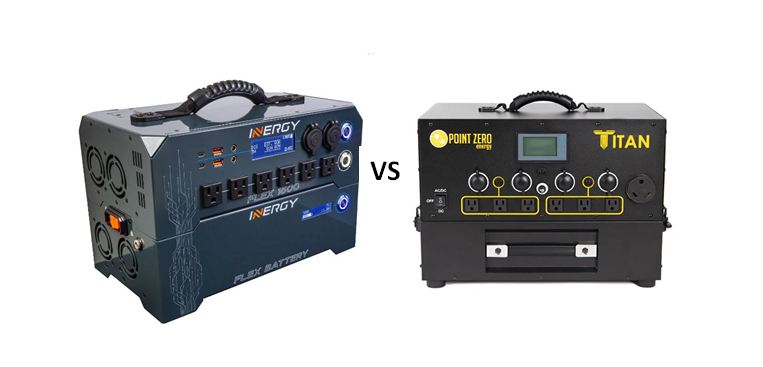Choosing between the Titan and Inergy Flex solar generators?
You’ve come to the right place.
Both Titan and Inergy Flex are modular solar generators with detachable battery packs. (link to individual reviews)
The modular design allows you to add or remove batteries whenever you want. They each come with a single detachable battery pack, but you can add others to increase capacity.
Unlike most expandable solar generators that limit how many extra batteries you can connect, you can add lots of capacity to the Titan or Inergy solar generators. This makes both of them a good pick for home backup and off-grid power.
In this one-on-one matchup, I compare the Titan solar generator vs. the Inergy Flex 1500 power station. I explain their differences, similarities, and which one you should pick depending on your needs.Titan vs. Inergy Flex: How Do They Compare?
Here’s a comparison table summarizing the main differences and similarities between the Titan and Inergy Flex power stations.
Titan Solar Generator | Inergy Flex Solar Generator |
|---|---|
1000Wh Li-ion battery | 2000Wh Li-ion battery |
Unlimited expansion | Expandable to 96kWh (96 batteries) |
1500W continuous, 3000W surge pure sine wave inverter | 3000W continuous, 6000W surge pure sine wave inverter |
6xAC, 2x60W USB-C PD, 2xUSB-A, 4x12V DC | 6 x AC, 1x30A RV, 4x12V DC |
14-90V, 400W max solar input | 35-145V, 2000W max solar input |
Fast charging options available | Fast charging options available |
Weight (with 1 battery): 29lbs | Weight (with 1 battery): 67lbs |
How Are The Titan And Inergy Flex Solar Generators Similar?
Before we get to the differences, let me first discuss one big similarity between these two solar generators.
When you look at them side by side, you’d think they are from the same manufacturer. They have almost the same rugged design. They are unlike most other portable power stations in the market.
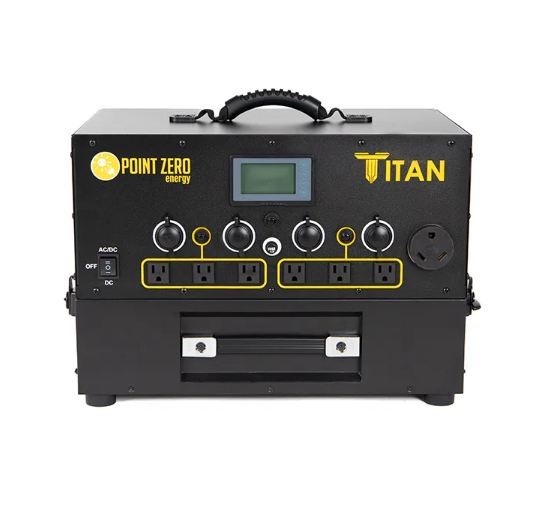
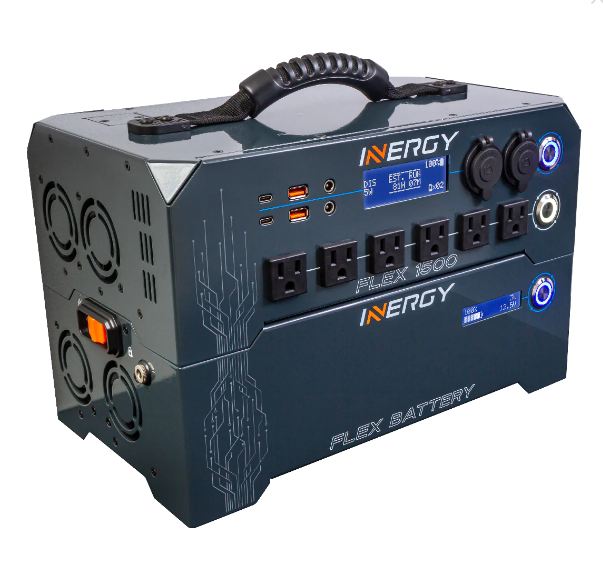
A more important similarity is their modular design.
Solar generators from Jackery, Bluetti and many other brands have everything, including the battery, integrated into one neat box.
Titan and Inergy Flex solar generators have a two-piece design. There’s the power module with the charger controller, inverter, and outlets. Then there’s a separate battery pack.
To connect the two, you simply stack the power module onto the battery pack.
This modular design has two big advantages.
Capacity
Now let’s look at the size of each solar generator’s battery pack.
The Titan solar generator comes with a single 2000Wh lithium-ion battery pack.
The Inergy Flex 1500 comes with a single 1000Wh lithium-ion battery pack.
So you get half the capacity when you order the Inergy Flex. But it doesn't matter since both solar generators are expandable.
But if you are shopping on a budget, the smaller Inergy Flex is the more affordable pick. You can then add more batteries over time.
Something to note is that both Titan and Inergy Flex use li-ion batteries, not LiFePO4 (lithium iron phosphate). This makes them lighter and more compact. On the downside, li-ion batteries last about half as long as LiFePO4 batteries (5yrs vs 10yrs).
If you prefer a LiFePO4 home backup or off-grid solar generator, my best recommendations are the Renogy Lycan 5000 or the EcoFlow Delta Pro.
Expandability
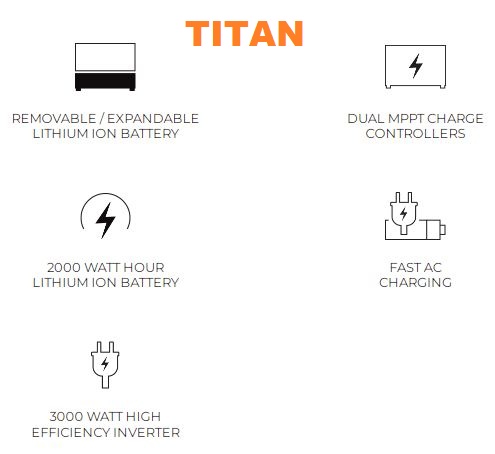
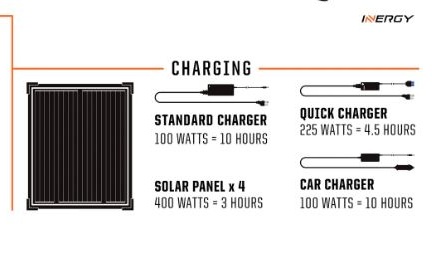
Both Titan and Inergy Flex solar generators are expandable.
Both Titan and Inergy Flex have virtually unlimited expandability.
Okay, only the Titan truly has unlimited expandability. If you get the Inergy Flex, you can add up to 96 batteries for a total capacity of 96kWh. I don't think many people will ever need that many batteries.
Another awesome thing about Titan and Inergy Flex is how easy it is to add extra batteries. You don't need wires or cables; you simply stack the batteries on top of each other.
Power Output
The Titan solar generator has a 3000W output (6000W surge), while the Inergy Flex solar generator has a 1500W output (3000W surge). Both use a pure sine wave inverter.
Power output is what really separates the Titan and Inergy Flex power stations.
While their capacity is also different, you can expand either to whatever capacity you want, so the Inergy Flex’s smaller battery size is not a big deal.
But when it comes to power output, the Inergy Flex is at a disadvantage. No matter how many batteries you add, you are limited by the 1500W output.
That means you can only power a couple or so large appliances at the same time.
In contrast, the Titan’s 3000W output means you can run multiple large appliances without tripping the inverter.
If you only plan to power small to medium size appliances like a mini fridge, TV, CPAP and so on, the Inergy Flex 1500 is up to the task.
If you plan to power larger appliances like a kitchen refrigerator, heater, portable AC or cooking range, the Titan solar generator is your best pick. It’s also great if you want to integrate the solar generator to your home grid.
Output Options
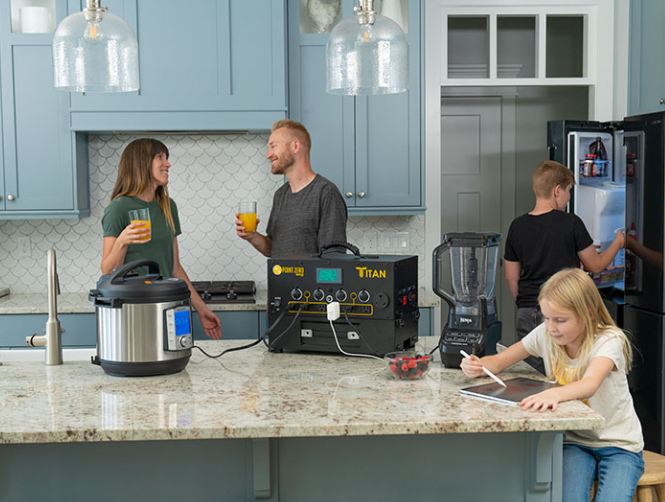
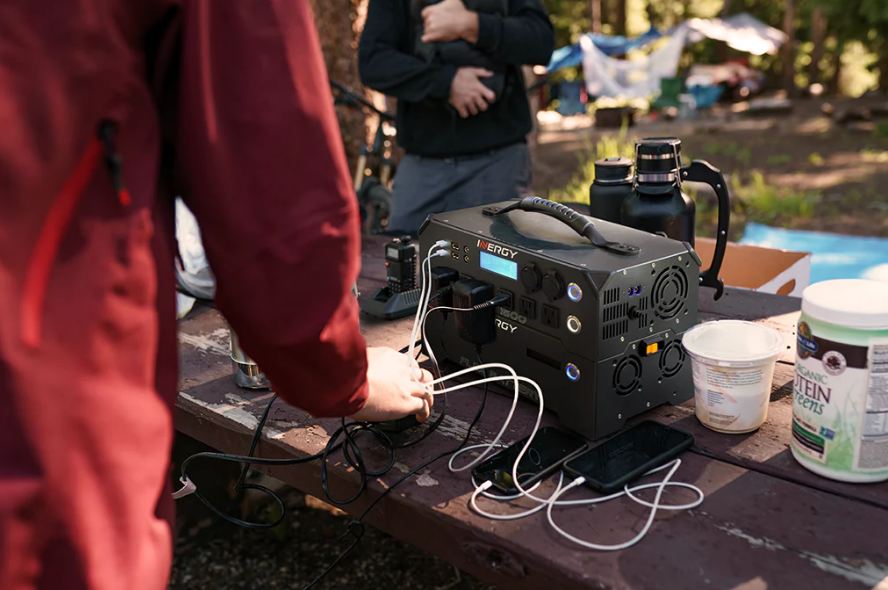
The Titan solar generator has 11 outlets, while the Inergy Flex 1500 has 14 outlets. Here’s how they break down.
Titan has six 120V, 15A AC outlets, which is great since you can run several appliances simultaneously to take full advantage of the powerful inverter.
There’s an extra 30A RV outlet for powering RVs or large appliances that pull more than 15A.
For your 12V electronics, there are four 12V car ports.
That’s it. The base model doesn't have USB ports. USB-A and USB-C adapters are only available as paid add-ons.
The Inergy Flex 1500 also has six AC outlets, though you have to be careful not to overload the inverter when running multiple appliances.
The base model includes four USB-outlets: two USB-A and two 60W USB-C PD.
You also get four 12V DC outlets: two car ports and two 5.5mm DC outlets.
Charging Options & Speed
Charging performance is important for expandable solar generators. You need a system that you can charge in a day.
Titan
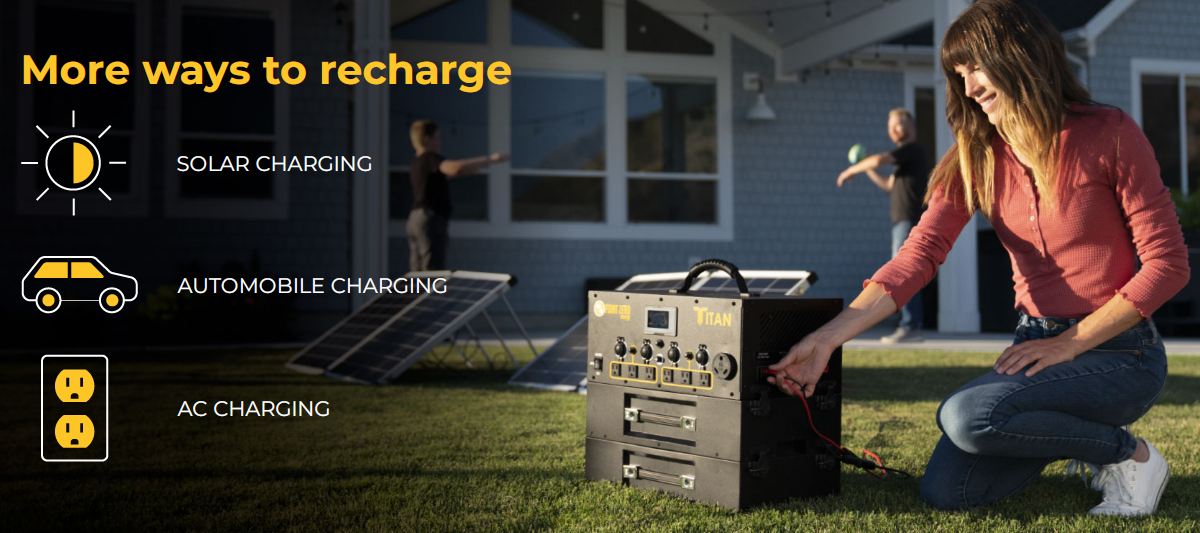
The Titan solar generator has the standard 3 recharge options: AC, solar and car charging.
A 14A AC charger is included with the base model, but you can order a more powerful 25A charger instead. The 14A charger takes 4-5 hours to recharge the Titan (with a single battery pack), while the 25A charger takes 2.5-3 hours.
For solar charging, Titan has dual MPPT charge controllers that accept up to 1000W of solar power each (35-145V). With a single battery pack, you can only use one of the input ports to put in 1000W max.
Get two or more battery packs and you can put in up to the maximum 2000W.
As for car charging, it takes close to 24 hours to recharge the battery. The car charger is available as a paid add-on.
Titan has a couple of additional charging options. You can use two 25A chargers, but only with two or more batteries. You can also combine all charging methods at the same time.
Inergy Flex
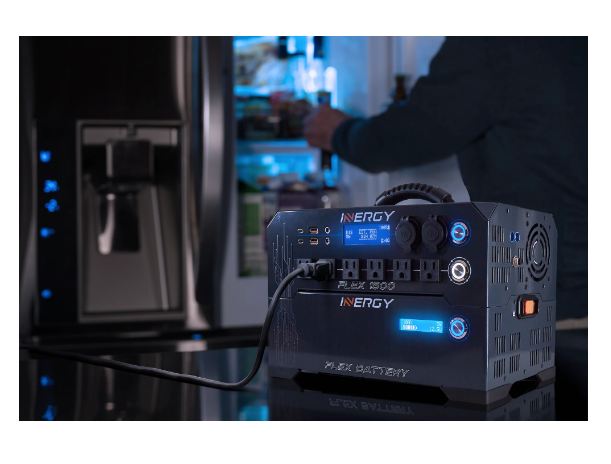
The Inergy Flex 1500 also has three standard recharge options: AC, solar, and car charging.
Similar to the Titan, Inergy Flex offers a slower AC charger with the base model. It takes about 10 hours to recharge a single battery pack.
You have to pay extra to get the faster AC charger that takes about 5 hours to charge a single battery pack.
But whether you get the slow or quick charger, the Inergy Flex 1500 charges too slowly especially considering it has a smaller capacity than the Titan.
Solar charging the Inergy Flex is faster. Max solar input is 400W (14-90V), meaning you can recharge a single battery pack in about 3.5 hours on a sunny day.
With the optional Flex MPPT Supercharger, which has two MPPT charge controllers, you can set up three separate solar arrays with a max voltage of 90V. This brings solar charging time down to just 1.5 hours.
The best part is that you can add more superchargers as you expand your Inergy Flex solar generator. So you can have five battery packs and still get the same quick 1.5hrs recharge time if you also get five superchargers.
That’s really cool if you are planning to order several extra batteries. The Titan solar generator doesn't have this option, so charging speed slows down as you add more batteries.
You can also combine AC, solar and car charging (car charger available separately), to charge the Inergy Flex quickly.
Weight
The combined weight of the Titan power module and one battery pack is 67lbs. Clearly, this is not a solar generator designed for camping and outdoors.
It works best if you set it up in one place and leave it whether it’s at home, in a van, RV or boat.
The Inergy Flex is a lot lighter at 29lbs, which is not surprising considering it has half the capacity and has a smaller inverter as well.
If you want a solar generator you can use at home and occasionally take with you on the road, pick the Inergy Flex 1500.
Warranty

The Titan power module has a 2-year warranty, while the battery packs have a 1-year warranty.
Inergy offers a 2-year warranty on the entire Inergy Flex system, including the battery packs.
Price & Value
The Titan solar generator is obviously the more expensive pick since it has twice the capacity and power output. Currently, it costs between $3,200 and $3,400 on Point Zero Energy’s official website.
The Inergy Flex 1500 costs between $1200 and $1500 on Inergy’s official website.
As for value for money, I think the Inergy Flex 1500 is a better bargain. Even accounting for the higher capacity and output, the Titan solar generator is a bit too pricey.
It also costs more than solar generators in the same size range.

